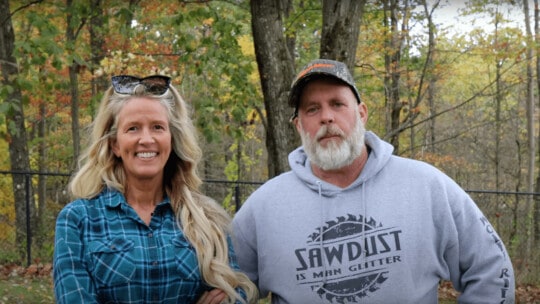If you live a rural lifestyle, knowing how to dry your firewood is crucial. Beyond that, knowing how to determine the ideal moisture content for firewood is pretty important. Why? If your firewood is too moist, it won’t burn correctly. So, get it right this season with advice from firewood expert, Mike Morgan—straight from the Outdoors with the Morgans YouTuber’s Western Pennsylvania homestead!
Mike’s property is filled with trees, namely black cherry (a.k.a., wild cherry) trees. They tend to be quite a bit taller than chokecherry trees, another common PA species. Mike cuts and dries his own firewood. Here’s how he goes about it.
The Importance of Dry Firewood
Firewood, explains Mike, contains stored energy. When the wood is dry, it burns efficiently and that stored energy turns into heat. Heat that, for instance, can help warm your house. Conversely, wet wood burns less efficiently. It produces less heat, but more smoke and creosote build-up in your chimney. Oh yeah, and it’s also much harder to light than its dry counterpart.
How Long to Dry Firewood
Deciding how long to dry firewood depends on how much moisture it contains. Trees that are considered “green” contain a lot of moisture. Mike points to a tree that was cut down about two weeks prior. “It’s a green tree, and what I mean by green is that it has a lot of moisture in it. As a matter of fact about half of this tree’s weight is water,” he explains. Mike splits a piece of newly cut wood open and uses a moisture meter to measure its moisture content. This particular piece of wood measures at 26.8% moisture, which means it’s not ready to burn. Mike pulls out another piece of wood that’s been cut and stacked for about four months. Its moisture level reads at 13.5%, which means it’s prime for burning.
How to Check for Moisture Content
There are several different ways to determine if your firewood is dry and ready to burn.
Check by weight. Dry firewood weighs a lot less than green firewood because it’s lost most of its moisture.
Check by sound. When two pieces of dry firewood are hit together they make a light hollow sound. Yet, when wet firewood is hit together, it makes more of a thud—a dense heavier noise.
Check by moisture meter. The third and most effective way to determine if firewood is dry, is to use a moisture meter. A generic inexpensive moisture meter will do the trick. Mike’s used the same one for roughly three years and considers it a cheap insurance policy.
Ideal Moisture Content for Firewood
Dry firewood is referred to as “properly seasoned.” The general rule of thumb is that properly seasoned firewood has a moisture content level of less than 20%. With some types of wood and climates, you can achieve this in four months. But, properly drying firewood also can take up to a year. Often wood is cut in the late fall or winter months and left to dry over the summer. Leaving wood to dry uncovered can help to speed up the process.
Can Firewood be Too Dry?
It doesn’t really matter if you buy or cut your own firewood. The important thing is to know if it’s dry and ready to burn. While you’re aiming to have wood with moisture content less than 20%, ultimately, you can’t really have firewood that is too dry. The only problem with having wood that is overly dry is that it will simply burn faster.



